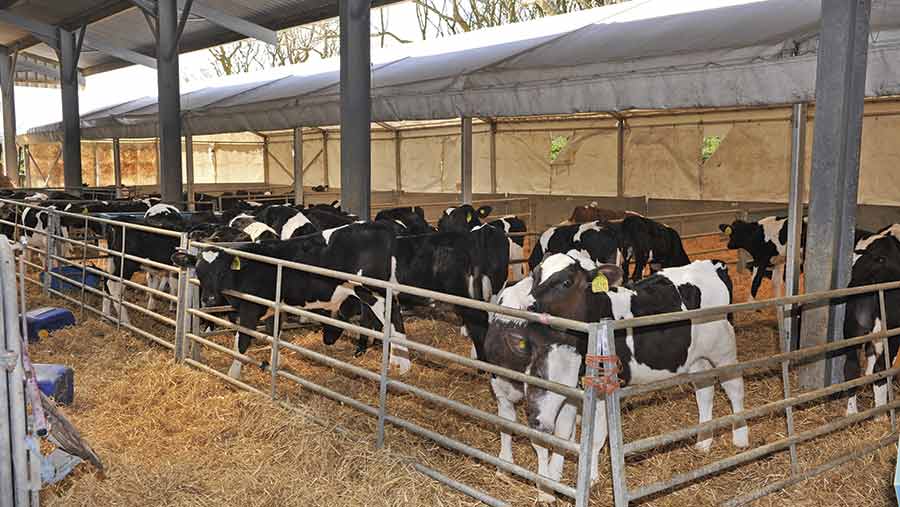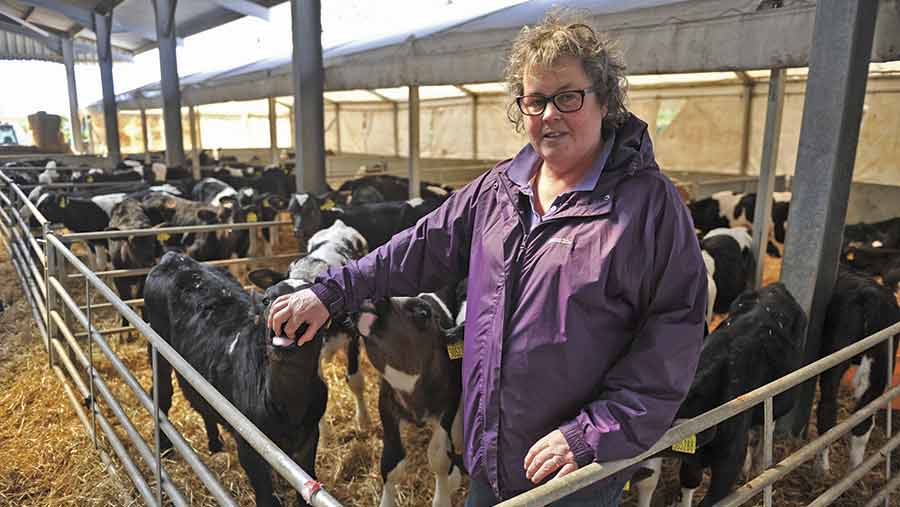Wedding marquee proves smart solution to house dairy calves
A block calving dairy unit is hiring ex-wedding marquees to house calves from birth to turnout to alleviate pressure on housing.
For the Jamieson family, who run a herd of 400 British Friesians and New Zealand Friesians at Hendre Eynon and Penberry Farms, St Davids, a marquee has provided an important solution for the wet, cold conditions that hindered turnout after calving got under way in February.
In previous years, stock would already have been at grass during the spring calving period and newborn calves housed in one of the empty sheds.
See also: Vet tips when using a marquee for calf housing

Faced with a housing challenge, the Jamiesons investigated temporary housing solutions and found the answer in hiring a marquee, formerly used for hosting functions such as weddings and shows.
“It was our son, Stuart, who came up with the idea of hiring in a marquee; he had seen an advert by the supply company,” says Eileen Jamieson.
The company providing the service charges £200 a week for the hire of a marquee measuring 6m by 27m. There is also a £500 fee for transporting the marquee to the farm and erecting and later removing it, and a £300 insurance fee.
“When you added the VAT it worked out at around £3,000 for 10 weeks,” explains Mrs Jamieson, who is in charge of calf rearing at the farm.
The marquee was erected at the open side of a steel-framed calf-rearing shed, effectively providing a single building, while existing hardcore provided an ideal floor surface.
Inside the marquee
Heifer calves were reared in pens in the permanent structure and beef bull calves in the marquee, where the Jamiesons had created pens using their own hurdles. Each pen was designed to accommodate 15 calves.
Bull calves were immediately housed in the marquee after they were born and given two, three-litre feeds of colostrum. From thereon they were reared on waste cow milk dispensed from teat feeders.

Over the 10-week calving and rearing period, the marquee housed two batches, a total of 120 calves.
Mrs Jamieson says it would have been very difficult to manage the squeeze on housing without the temporary accommodation. “We calve in a very tight block. We calved half the herd in the first two weeks so we had calves everywhere.”
The Jamiesons calve over a 12-week period but are planning to reduce this to 10 weeks next spring.
Ventilation
Ventilation was good because it could be controlled.
“We positioned straw bales at both ends to stop the wind from blowing in. We could open both ends so when the weather warmed up that aided ventilation,” Mrs Jamieson explains.
“The marquee had all the elements thrown at it this year, every possible weather extreme.”
Calf health was good for the entire 10-week period.
“The calves have done as well as those in the shed, they are in great condition and their growth rates have been superb,” says Mrs Jamieson. Bull calves, mostly Herefords, are sold to a private buyer. Daily growth rates in the bull calves is just under 1kg.
Hiring a marquee also allowed for ease of management. “It meant that all the calves were under the same roof, heifers and bulls.”
Cost benefit
The marquee was removed in the first week of May, but Mrs Jamieson says it is a resource that the family will use again next year.
“The current milk price rules out building a new shed,” she says. “The only downside of marquee hire is that it is an annual cost – a shed is permanent – but there are many benefits.’’
James Henman, of Henman’s Marquees, has seen a big rise in interest from livestock farmers in recent years. He says marquees appeal because they provide almost instantaneous access to housing and allow flexibility on size. “The first job we did was when a farm burned down and the farmer needed housing for lambing,” Mr Henman recalls.
Many of his customers are tenant farmers. “If they only have the land for a few years they don’t want to invest a lot of money in putting up sheds.”
Mr Henman ensures strict biosecurity measures are adhered to prevent cross-contamination of diseases between farms. “The marquees are steam cleaned when we put them up and when we take them down.”
